
Josiah Bartlett was an American Founding Father, physician, statesman, a delegate to the Continental Congress for New Hampshire, and a signatory to the Declaration of Independence and Articles of Confederation. He served as the first governor of New Hampshire and chief justice of the New Hampshire Superior Court of Judicature.
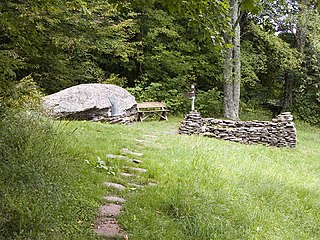
Woodchuck Lodge is a historic house on Burroughs Memorial Road in a remote part of the western Catskills in Roxbury, New York. Built in the mid-19th century, it was the last home of naturalist and writer John Burroughs (1837-1921) from 1908, and is the place of his burial. The property is now managed by the state of New York as the John Burroughs Memorial State Historic Site, and the house is open for tours on weekends between May and October. The property is a National Historic Landmark, designated in 1962 for its association with Burroughs, one of the most important nature writers of the late 19th and early 20th centuries.
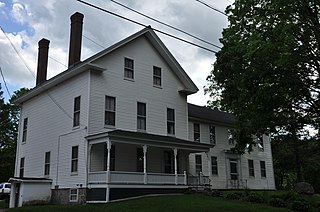
The Daniel Webster Family Home, also known as The Elms, is a historic house off South Main Street in West Franklin, New Hampshire. The house has been designated a National Historic Landmark for its importance as the summer home of Daniel Webster (1782–1852), who owned it from 1829 until his death.

The John Paul Jones House is a historic house at 43 Middle Street in Portsmouth, New Hampshire. Now a historic house museum and a National Historic Landmark, it is where American Revolutionary War naval hero John Paul Jones, resided from 1781-82 when it was operated as a boarding house. He also lived in a home in Fredericksburg, Virginia, on Caroline Street, owned by his brother.
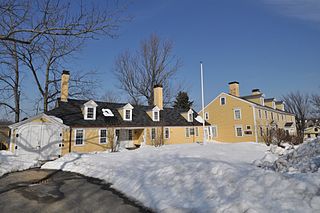
The Ladd-Gilman House, also known as Cincinnati Memorial Hall, is a historic house at 1 Governors Lane in Exeter, New Hampshire, United States. The home was built about 1721 by Nathaniel Ladd as one of the state's first brick houses, and was subsequently clapboarded three decades later. The home was purchased in 1747 by Daniel Gilman, a prominent Exeter merchant. It served as the state treasury during the American Revolutionary War when two members of the Gilman family, Col. Nicholas Gilman and his son John Taylor Gilman, later the state's governor, served as treasurers of the state. Also born in the house was Founding Father Nicholas Gilman, Jr., a signer of the United States Constitution and U.S. senator from New Hampshire.

Joy Farm, also known as the E. E. Cummings House, is a historic farmstead on Joy Farm Road in the Silver Lake part of Madison, New Hampshire. It was designated a National Historic Landmark in 1971 in recognition for its place as the longtime summer home of poet E. E. Cummings (1894–1962).

Salmon P. Chase Birthplace was the birthplace and childhood home of Salmon P. Chase. It is located about 8 miles (13 km) north of Claremont on New Hampshire Route 12A. The 2+1⁄2-story wood-frame house was built c. 1790, and is a multi-section structure in an L shape. The main block is five bays wide and two deep, with a centered entry that has Greek Revival pilasters on the central entry and on the corners. This block faces west, and two narrower sections extend east from the rear. The first of these sections is also 2+1⁄2 stories, with two chimneys. The easternmost section is 1+1⁄2 stories, and was originally connected to a barn. The house is believed to be well-preserved, but there is no documentary evidence of its appearance in the early 19th century, and it is known to have been moved across the street from its original site in about 1848.

The Matthew Thornton House is a historic house and National Historic Landmark in Derry, New Hampshire. It was from 1740 to 1779 the home of Matthew Thornton, a Founding Father and signer of the U.S. Declaration of Independence.

The Wentworth-Gardner House is a historic mid-Georgian house, located at 50 Mechanic Street in Portsmouth, New Hampshire, United States. The house is operated as a museum by the Wentworth-Gardner Historic House Association. It is one of the finest extant examples of high-style Georgian architecture in New England, and played a role in the architectural preservation movement of the early 20th century. It was declared a National Historic Landmark in 1968.

The Playmakers Theatre, originally Smith Hall, is a historic academic building on the campus of the University of North Carolina at Chapel Hill. Built in 1850, it was designated a National Historic Landmark for its architecture, as an important example of Greek Revival architecture by Alexander Jackson Davis. It is now a secondary venue of the performing company, which is principally located at the Paul Green Theatre.

College Hill, also known as George Walton House, Harper House, or Walton-Harper House, is a historic house at 2116 Wrightsboro Road in Augusta, Georgia. It was built in 1795, and was the home George Walton, a signer of the United States Declaration of Independence, from then until his death in 1804. It was declared a National Historic Landmark in 1971. It is a private residence, and is not open to the public.
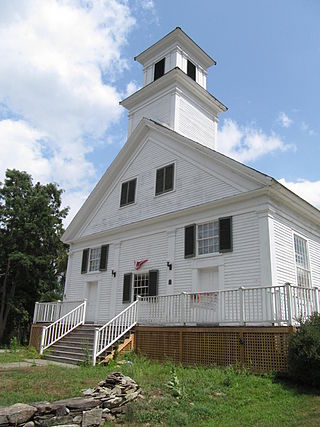
The Asbury United Methodist Church is a historic Methodist church on NH 63 in Chesterfield, New Hampshire. It has been termed the "mother church of Methodism in New Hampshire", and is home to the state's oldest continuously running Methodist congregation, organized in 1795. The building, constructed in 1844, is a prominent local example of Greek Revival architecture, and was listed on the National Register of Historic Places in 1983.
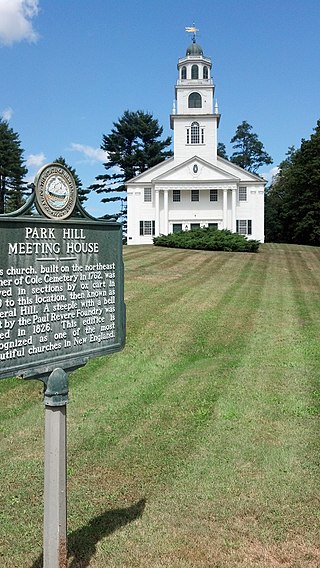
The Park Hill Meetinghouse is a historic meeting house on Park Hill in Westmoreland, New Hampshire. Built in 1764, and extensively restyled in the early 19th century, it is a fine example of Federal and Greek Revival architecture, influenced by the work of regionally prominent architect Elias Carter. The building was listed on the National Register of Historic Places in 1980. It is now owned by the Westmoreland Park Hill Meetinghouse and Historical Society.

The United Church of Christ in Keene is a historic Congregational church at 23 Central Square in Keene, New Hampshire, United States. First built in 1786, and then moved and restyled in the 19th century, it is a prominent visual and architectural landmark in downtown Keene. The church and its adjacent parish house were listed on the National Register of Historic Places in 1982.

The Thomas and Maria Blackman Bartlett House was built as a private house at the corner of Canton Center and Warren Roads. It was donated to Canton Township and relocated to its current site at 500 N. Ridge Road in Cherry Hill, Michigan. It was listed on the National Register of Historic Places in 2000.

The Josiah Wilcox House is a historic house at 354 Riversville Road in Greenwich, Connecticut. Built in 1838, it is one of the town's finest examples of Greek Revival architecture. It was listed on the National Register of Historic Places in 1988.

The High Tops School, also known as Schoolhouse No. 9, is a historic school building at the corner of Reynolds and River roads in Westmoreland, New Hampshire. Built in 1789 and remodeled in 1846, it is one of a small number of district schoolhouses in the region to survive demolition or adaptation to residential use. The building was listed on the National Register of Historic Places in 1984, and the New Hampshire State Register of Historic Places in 2007. It is now owned by the Westmoreland Park Hill Meeting House and Historical Society.

The Abijah Richardson Sr. Homestead is a historic house at 359 Hancock Road in Dublin, New Hampshire. Built about 1795, it is one of Dublin's oldest houses, built by Abijah Richardson Sr., one of the town's early settlers and progenitor of a locally prominent family. The house was listed on the National Register of Historic Places in 1983.

Weldwood is a historic summer estate house on Old Troy Road in Dublin, New Hampshire. Built in 1902–03, it is an unusual example of Greek Revival architecture from the early 20th century. The house was listed on the National Register of Historic Places in 1983.
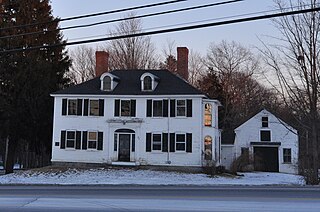
The Bartlett-Cushman House is a historic house at 82 Portsmouth Road in Stratham, New Hampshire. Built about 1810, it is one of the town's best examples of Federal-style architecture. It was listed on the National Register of Historic Places in 2014.























